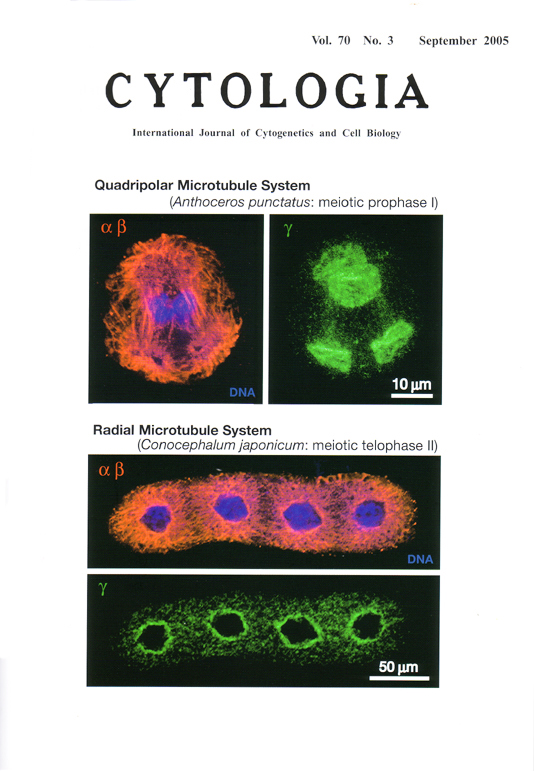| ON THE COVER |  |
|---|---|
| Vol. 70 No.3 September 2005 | |
| Technical note | |
|
|
|
| Membrane-associated microtubule-organizing centers in basal land plants
Microtubules play essential roles in cell morphogenesis. A typical microtubule organizing center (MTOC) is a centrosome. a compound structure that is composed of a centriole pair embedded in an amorphous matrix. Animal and algal cells use centriolar centrosomes to initiate microtubules. By contrast, flowering plants lack MTOCs comparable to animal centrosomes. In the evolution of land plants, it is not clear why flowering plants 'chose' acentriolar microtubule system in morphogenesis. The oldest living lineage of land plants, the bryophytes, represent a pivotal group for considering the evolution of the microtubule system in land plant. The membrane-associated microtubule systems shown here (quadripolar and radial microtubule system) are unique in basal land plants and are considered a transitional state between algal centriolar MTOCs and the acentriolar MTOCS of flowering plants. In the figures, meiotic cells were triple labeled for anti-â┐- and -â└-tubulins, DAPl, and G9 anti-â┴-tubulin. The subcellular localization of microtubules (red signal) and DNA (blue signal) are shown in an overlain image. The â┴-tubulin localization (green signal) is shown in a separate image. Sporocytes of Anthoceros punctatus (hornwort) have a single plastid, which divides into four plastids before meiotic nuclear division. Microtubules initiate from the surface of dividing plastids and form a quadripolar microtubule system. â┴-tubulin, a ubiquitous component of the MTOC, locates on the plastid surface (upper figurcs).This quadripolar microtubule system determines not only the positions of the four daughter plastid but also the position of division plane insertion. Cell plates in telophase I in polyplastidic sporocytes of Conocephalum, japonicum(liverworts) disappear and the three cytokinetic division sites in meiosis are determined in telophaseçUby a radial microtubule system in which microtubules emanate from four daughter nuclei. This microtubule system with nuclei seems to ensure the equal distribution of the cytoplasm between the four spores. During formation of the radial microtubule system, locates on the nuclear surface (lower figures) (See Shimamura, M., Brown, R. C., Lemmon. B. F.., Akashi, T., Mizuno, K., Nishihara, N., Tomizawa, K., Yoshimoto, K., Deguchi. H., Hosoya, H., Horio. T., and Mineyuki, Y. 2004. Plant Cell (16: 45-59.) (Yoshinobu Mineyuki1 and Masaki Shimamura2, 1 Dcpartment of Life Science, Graduate School of Life Science University of Hyogo, Shosha 2167, Himeji, 671-2280, Japan, 2 Plant Molecular Physiology Laboratory, Research Institute of Innovative Technology for the Earth, 9-2 Kizugawadai, Kizu-cho, Soraku-gun, Kyoto, 619-0292, Japan) | |